Find out how to eat a healthy plant-based diet with our vegan food pyramid & critical nutrient printables! Read the full article for our top nutrition tips.
When you first go vegan, you usually have no clue what to eat in a day — let alone how to meet all of your nutritional needs on a fully plant-based diet!
This guide aims to lay the foundation of a healthy vegan diet, portion sizes, food groups and what nutrients to look out for because you might fall short of them.
It can be confusing because we learned that animal products play such a vital role in our diet. But with some smart vegan food swaps and supplementation, it’s totally possible to follow an enjoyable and well-rounded plant-based diet.
Whether you want to gain weight, lose weight, need to eat low-fiber or need to stay on a budget, our vegan food pyramid gives you a better understanding and offers you a general eating guideline!
Free vegan food pyramid download
Get your FREE printable “Vegan Food Pyramid” & “How to Meet Critical Nutrients on a Vegan Diet” sheet.
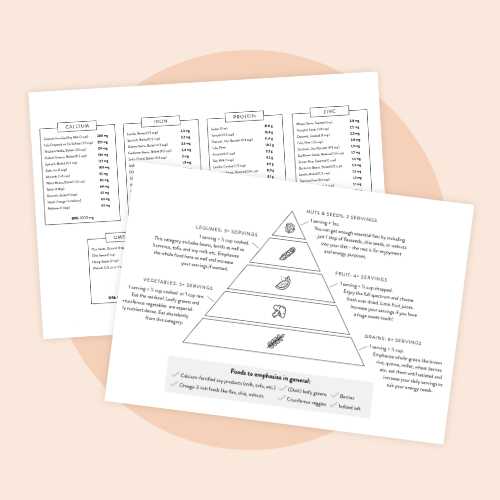
download our free vegan nutrition printables
Grab your free PDF and sign up for our newsletter by entering your email below!
Is a vegan diet healthy?
Are you under the impression that following a vegan diet is very complicated and can result in many side effects? We know that this message is all over the media and in most people’s heads, but let’s fact-check this.
In 2009, the Academy of Nutrition and Dietetics published a position paper on vegetarian diets which stated that
“appropriately planned vegetarian diets, including total vegetarian or vegan diets, are healthful, nutritionally adequate, and may provide health benefits in the prevention and treatment of certain diseases. Well-planned vegetarian diets are appropriate for individuals during all stages of the life cycle, including pregnancy, lactation, infancy, childhood, and adolescence, and for athletes.”
It further says the following: “The results of an evidence-based review showed that a vegetarian diet is associated with a lower risk of death from ischemic heart disease.
Vegetarians also appear to have lower low-density lipoprotein cholesterol levels, lower blood pressure, and lower rates of hypertension and type 2 diabetes than non-vegetarians.
Furthermore, vegetarians tend to have a lower body mass index and lower overall cancer rates. Features of a vegetarian diet that may reduce the risk of chronic disease include lower intakes of saturated fat and cholesterol and higher intakes of fruits, vegetables, whole grains, nuts, soy products, fiber, and phytochemicals.”
Similar associations formed by nutrition experts in other countries have come out with statements along those lines.
What’s more, pretty much all major health organizations want us to eat more fruits, veggies, whole grains and legumes and less “saturated fat, trans-fat and cholesterol”.
The last 3 nutrients are kind of code words for animal products since they are the main sources of these fats and the only source of dietary cholesterol.
Reasons To Go Vegan →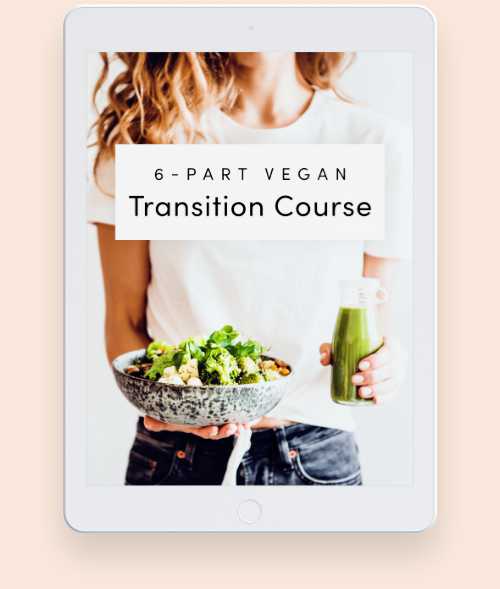
join our free vegan course!
Learn how to thrive on a plant-based diet with practical tips & a 3-day meal plan!
The vegan food pyramid
What does an “appropriately-planned” vegan diet these dieticians are talking about look like?
Well, it’s made up of the major plant-based food groups and it shows you how you can create balanced meals out of different tasty and healthy components.
Considering the official guidelines and recommendations made by large organizations, such as the USDA, that are not specifically advocating for a vegan diet but still mention calcium or iron as critical nutrients to look out for, here’s what you should approximately be eating!
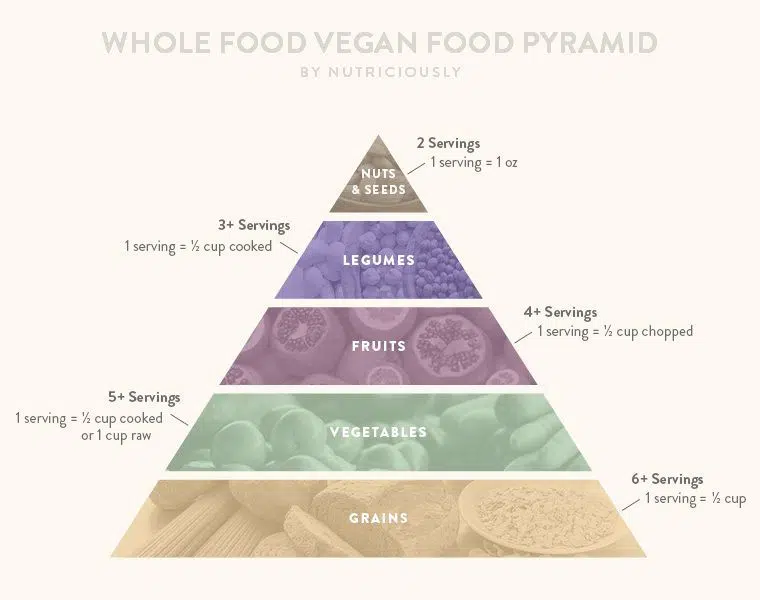
Vegan food groups
Let’s look at the different sections of the food pyramid and give you some more details about what each of them encompasses.
1. Grains
Emphasize whole grains when possible and eat unprocessed grains like brown rice, quinoa, millet, wheat berries, or buckwheat. Other choices are hot or cold cereal, bread and pasta.
Reduce your intake of cookies, pastries, and cakes. Whole starches should provide you with the bulk of your calories, eat them until satiated and increase your daily servings to suit your energy needs.
2. Vegetables
Both raw and cooked vegetables are healthy and should be included in your daily diet. Eat the rainbow by choosing all kinds of colors. Leafy greens and cruciferous vegetables are especially nutrient-dense and good to include but no need to skip the starchy root vegetables.
If you cannot eat a large bulk of food, make vegetable smoothies or soups for adequate nutrient intake. Eat abundantly from this category but make sure to have enough energy-dense foods daily.
3. Fruit
Enjoy the full spectrum and have fruit for breakfast, snacks or dessert. Choose fresh over dried, and include all the colors. Limit fruit juices.
Increase your servings if you’re still hungry or have a huge sweet tooth!
4. Legumes
This category includes cooked beans and lentils as well as hummus, bean burgers, tofu, and soy milk.
Choose calcium-fortified when possible and limit vegan meat substitutes with isolated soy protein or protein powders. Emphasize the whole food here as well and increase your servings if wanted.
5. Nuts and seeds
Focus on flaxseeds, chia and seeds and walnuts to get enough omega-3 essential fatty acids and if you’re trying to lose weight, watch your portion sizes.
Nuts and seeds are highly nutritious; however, they also pack a lot of calories. Use nut or seed butter, such as tahini, to make creamy sauces or healthy desserts!
Healthy Vegan Fat Sources →Foods to emphasize
Having some of the following foods daily goes a long way when it comes to meeting your nutritional needs on a plant-based diet!
- Calcium-fortified soy products (milk, tofu, etc.)
- (Dark) leafy greens
- Cruciferous veggies
- Berries
- Omega-3 rich foods like flax, hemp seeds, chia, walnuts
- Iodized salt or kelp flakes
Meeting nutritional needs as a vegan
While it’s not too hard to get everything you need on a vegan diet, there are a few nutrients and their daily recommended intakes (DRI) we should take a closer look at.
Calcium
The DRI is 1000 mg for most adults, slightly more for elderly people and teenagers. This mineral is important for bone health as well as muscle and nerve function.
It’s important to note that an adequate intake of vitamin D (more on that below) is essential for proper calcium absorption. Soy products and plant-based milks are often fortified with calcium.
Calcium sources
- Vegetables: Rhubarb Stalks, Collard Greens, Spinach, Kale, Broccoli
- Fruit: Navel Oranges
- Legumes: Calcium Fortified Soy Milk, Calcium Set Tofu, White Beans
- Nuts & Seeds: Almonds, Tahini
- Other: Molasses
Iron
The DRI is 8 mg for males and 18 mg for females in their reproductive years due to the monthly blood (and iron) loss. Iron is necessary for oxygen transport throughout the body, the immune system, and DNA synthesis.
Our bodies can store iron and increase absorption when the stores get low. Non-home iron (from plant sources) isn’t absorbed as well as home iron (from animal products), though it is safer to consume and linked to a decreased risk of disease.
We can enhance iron absorption by adding vitamin C to iron sources and not consuming tea or coffee with or right after our meals.
Iron sources
- Grains: Oatmeal
- Vegetables: Spinach, Swiss Chard, Collard Greens
- Fruit: Dried Figs
- Legumes: Lentils, Kidney Beans, Chickpeas, Green Peas
- Nuts & Seeds: Tahini, Almonds
- Other: Molasses
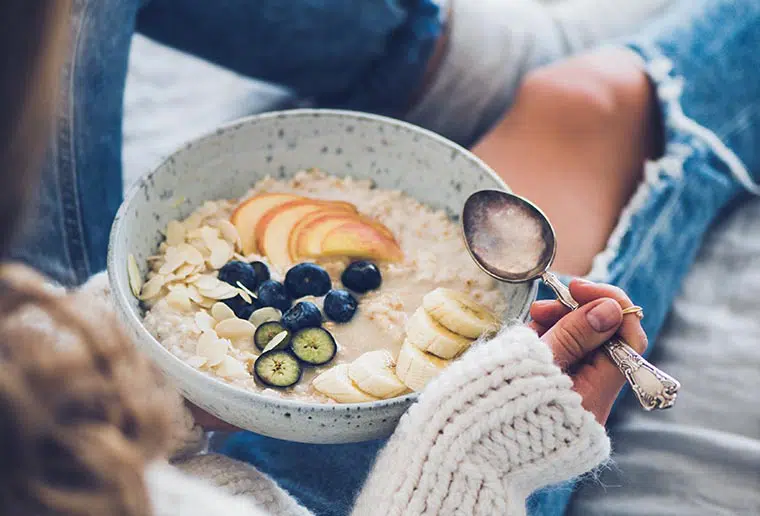
Zinc
The DRI is 8 mg for females and 11 mg for males here. It’s an important mineral that plays a role in the structure of DNA and the immune system. The bioavailability can be diminished by inhibitors in nuts, grains, and legumes, so you might want to consume a little more than the DRI as a vegan.
Zinc sources:
- Grains: Wheat Germ, Oatmeal, Brown Rice
- Legumes: Tofu, Chickpeas, Lentils, Peanuts, Peas
- Nuts & Seeds: Pumpkin Seeds, Cashews, Sunflower Seeds, Almonds
Iodine
The DRI here is 150 mcg for adults (more when pregnant or lactating) with an upper limit of 1100 mcg.
Iodine is used in the production of thyroid hormones and is important for our metabolism. It’s unclear yet whether or not vegans and vegetarians are really at risk for a deficiency here but better safe than sorry.
⅓ teaspoon of iodized salt per day already contains 100 mcg but if you don’t meet your iodine needs by way of salt, you should opt for a supplement.
Iodine sources:
- Iodized salt
- Supplements
- Kelp (content varies & possible contamination, therefore not recommended)
Protein
Ah, the holy nutrient! Let’s tackle the protein fear here really quick – for a more in-depth answer, read our article linked below. This essential macronutrient has important functions, such as maintaining muscle and bone mass, or supporting the immune system.
The original source of all essential amino acids (the building blocks that protein consists of) comes from the plant kingdom, and no specific combination of foods is needed to get a “complete protein.”
The average Western person eats way too much protein, as the DRI for adults is only 0.8 g per kilogram of body weight (which comes to around 50 grams per day for a person at a healthy weight). While vegans can get all of the protein they need from plants, lysine (one essential amino acid) is a little harder to come by but is found in many legumes.
It’s not hard to meet daily protein needs while eating a varied whole foods vegan diet since every unprocessed food contains at least some amount, but just to be sure, here’s a list of some high protein vegan foods.
Protein sources:
- Grains: Seitan, Amaranth, Quinoa, Whole Wheat Spaghetti
- Legumes: Tempeh, Peanuts, Tofu, Soy Milk, Lentils, Beans
- Nuts & Seeds: Pumpkin Seeds, Almonds
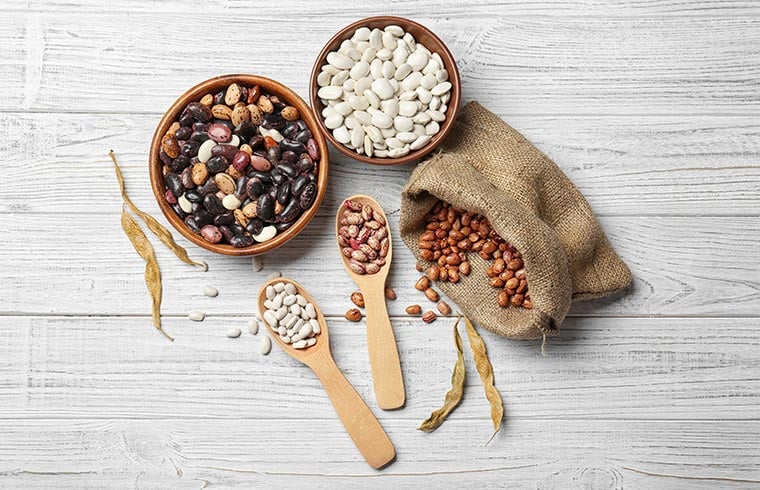
Omega-3 (ALA)
Fish-free omega 3? Yes, that’s possible. The essential fatty acid alpha-linolenic acid (ALA) originally comes from plants and is converted to omega-3 in our bodies.
These conversion rates may improve when omega-6 consumption is lower (reducing your intake of most oils and some nuts/seeds), so choose certain fat sources over others.
Omega-3 fatty acids are linked to heart health, brain development, and other benefits, so we definitely don’t want to miss out here!
Newer research suggests that some people, especially the elderly, aren’t so good at converting ALA to the long-chain fatty acids DHA and EPA and should, therefore, take an algae-based supplement. 200-300 mg DHA every 2-3 days is a good guideline. The DRI for ALA is 1.1 g for females and 1.6 g for males.
ALA (Omega-3) sources:
- Nuts & Seeds: Flax Seeds, Chia Seeds, Hemp Seeds, Walnuts
- Small amounts can be found in seaweed, edamame, kidney beans, Brussel sprouts
- Supplements
Vitamin D
This vitamin (which is actually a hormone) is produced in the kidneys and promotes calcium absorption as well as bone growth, immune health, and muscle function.
Very few foods naturally contain vitamin D, like fatty fish or egg yolks. Luckily, we produce it after sunlight exposure – which is why everyone, vegan or not, should supplement during the colder and darker months of the year.
You will also find that many foods are fortified with vitamin D, such as plant-based milk, orange juice, or cereals. There are also some mushrooms that were exposed to light that can provide you with this nutrient (it will say so on the package).
The most reliable source, however, is taking a vitamin D supplement. The DRI is 15 mcg or 600 International Units for adults.
Vitamin D sources:
- Sun exposure for 10-15 minutes (white skin color) or 15-20 minutes (dark skin color) on a day when sunburn is possible
- Vitamin D2 or Vegan Vitamin D3 Supplement
Vitamin B12
Vitamin B12 is created by bacteria and fungi that would naturally occur on our food and in our drinking water – but through sterilization practices and cleanliness standards in food production, it is being removed (along with all the “bad guys”).
The reason why we can get B12 from animal-based foods is that their feed or water is either contaminated with these bacteria, they are being supplemented, or they eat their own poop.
Yes, B12 can be made by the gut and excreted. Over one-third of the general population is low in this essential nutrient and should take a supplement – vegan or not.
Everyone over the age of 50 should supplement it. Vitamin B12 has many important functions, such as red blood cell formation, central nervous system maintenance, and a few more.
There are no reliable, unfortified plant sources of vitamin B12 (including fermented products, sea vegetables, or organic produce) – though our B12 stores can last up to a few years, the consequences of deficiencies aren’t funny and supplementation is cheap, easy, and safe.
Despite the low DRI of 2.4 mcg, it’s good to take a larger dose of B12 since only a fraction is absorbed and it’s impossible to overdose on a water-soluble vitamin. The preferred form of B12 is cyanocobalamin and the recommendation for a daily dose is 250 mcg, a weekly dose is 2500 mcg (depending on how often you want to take a supplement).
Vitamin B12 sources:
- Daily Dose of 250 mcg Cyanocobalamin
- Weekly Dose of 2500 mcg Cyanocobalamin
- Fortified foods (in combination with supplements)

download our free vegan nutrition printables
Grab your free PDF and sign up for our newsletter by entering your email below!
How much should I eat on a vegan diet?
Meet your daily caloric needs by eating at least 5 portions of fruits and veggies each day and base your meals on potatoes, bread, rice, pasta and oats.
Add legumes to most meals and stick to calcium-fortified dairy alternatives. Choose unsaturated fats over saturated fats and keep added sugars low if possible!
The USDA recommends that the average, sedentary female needs at least 1800 calories every day to function normally.
There’s really no need to cut back on calories even if you load up on carbs or healthy fats — also, don’t neglect any of the plant-based food groups completely!
Be sure you eat enough food and if you tend to have a small appetite, check out these healthy vegan foods for weight gain.
Please be aware of this calorie difference between animal-based and plant-based foods — processed versus whole foods.
Overall, we always suggest you listen to your hunger signals and never deprive yourself of food when you feel you need to eat something.
Sticking to some kind of number or “goal” you’ve set for yourself isn’t necessarily the best thing for your body and you can only stay hungry for so long until you’ll dive into the next bag of potato chips.
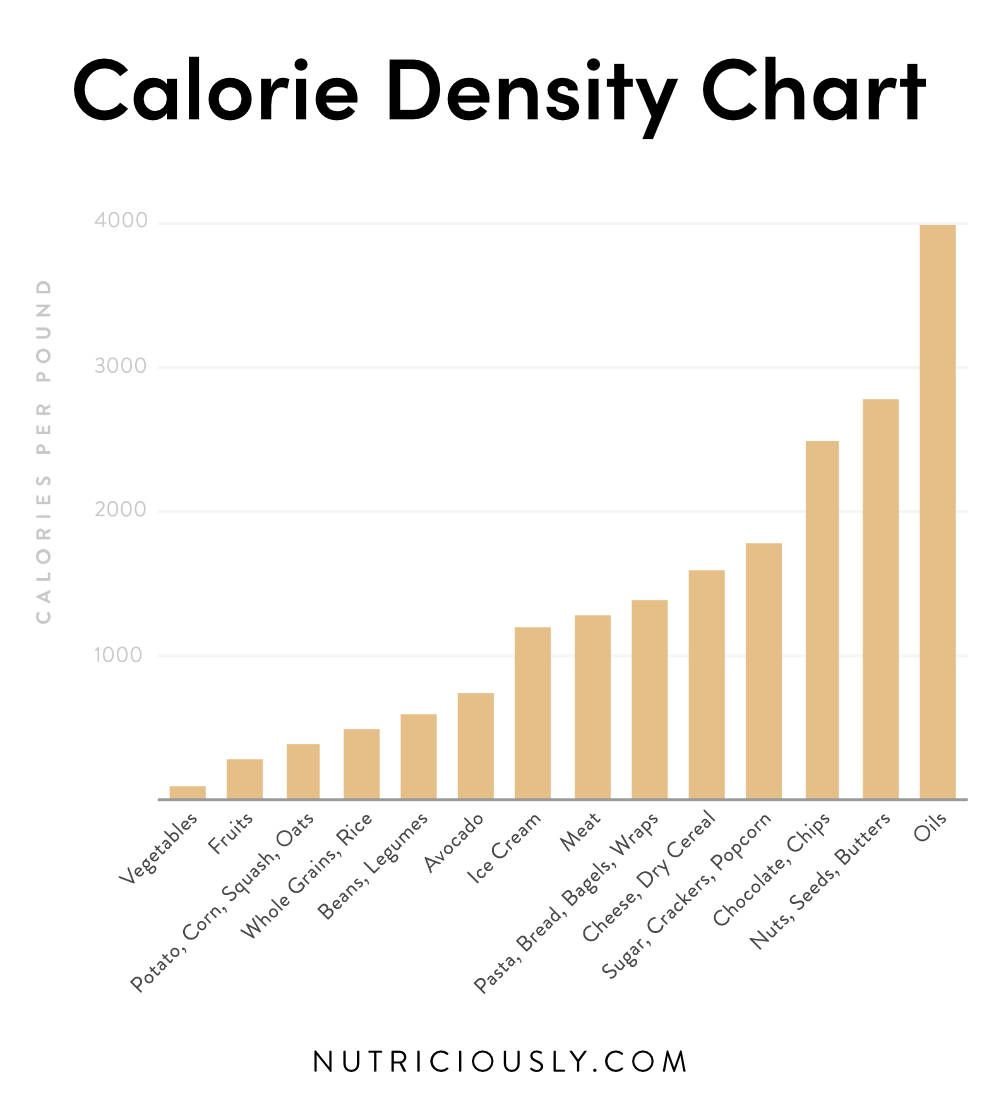
Calorie counting or portion controlling isn’t really necessary on the vegan diet as we promote it because of the huge bulk (fiber) these foods provide. When you keep the oils and added sugars low or even skip them altogether, most people naturally come to and stay at a healthy weight.
Remember, the recommendations you can see on our vegan food pyramid are the minimum amounts you should get of each food group but you’ll probably need to eat more to have enough energy for the day.
After all, we cannot give out broad advice that will be perfect for each individual – at the end of the day, you’ll still have to make it work for you in your everyday life.
More vegan guides
Check out the following article for more guidance!
- Whole Food Plant-Based Diet
- Healthy Food Swaps
- Vegan Staple Foods
- Transition to a Vegan Diet
- Best Vegan Books
Did you find this vegan nutrition guide helpful and did you change anything about your diet after reading it? Let us know in the comments below, share this article on social media and Pin it here.

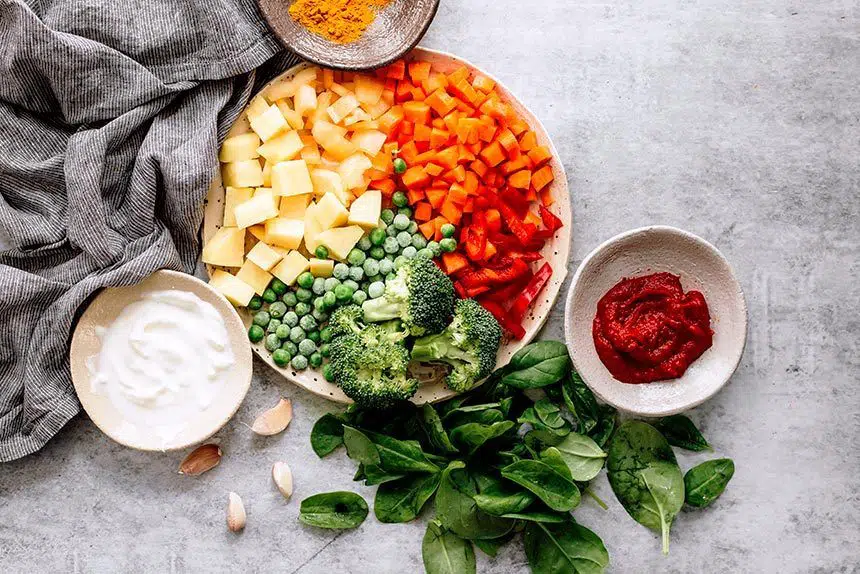
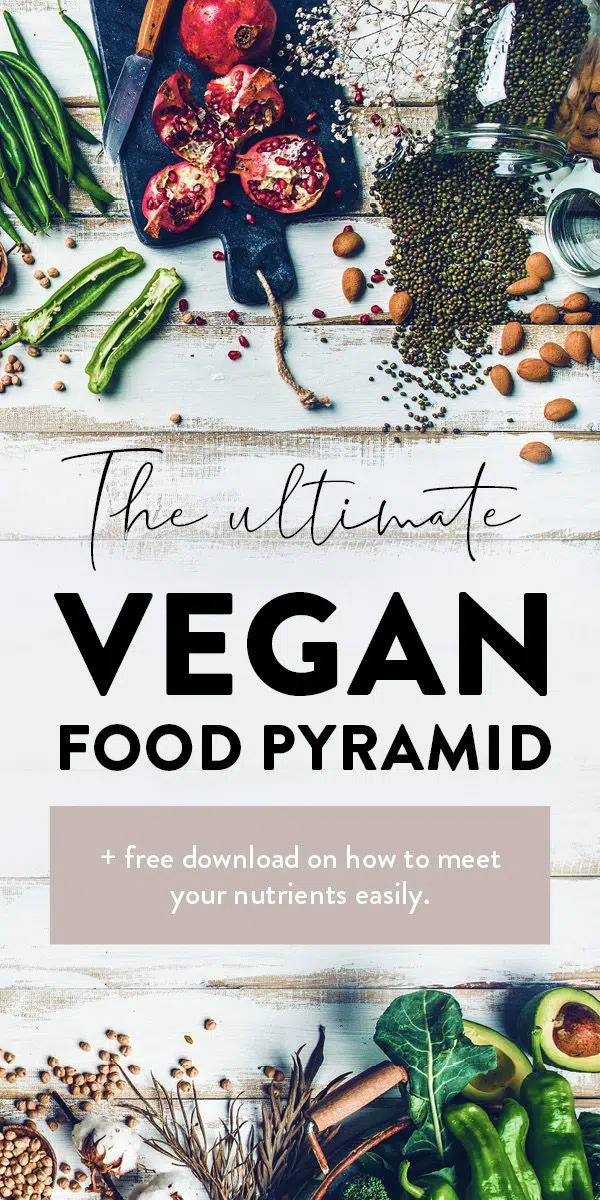
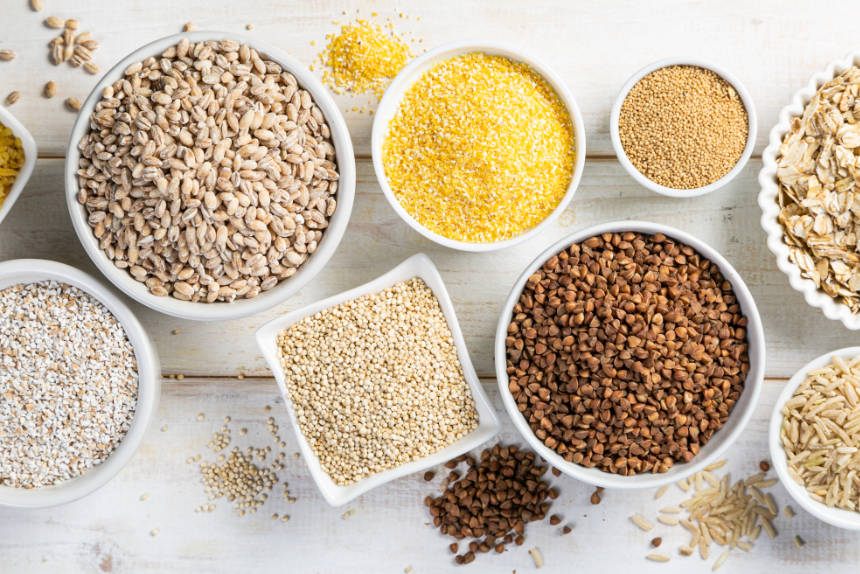
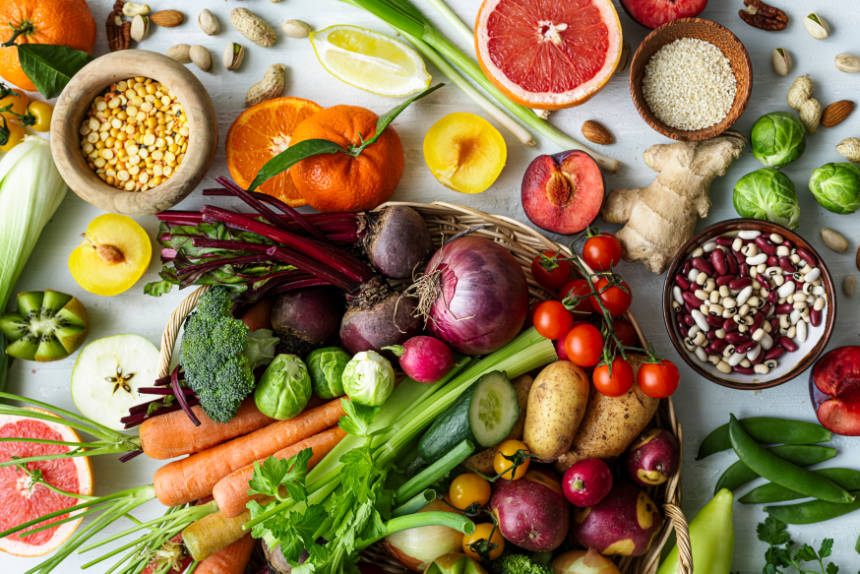
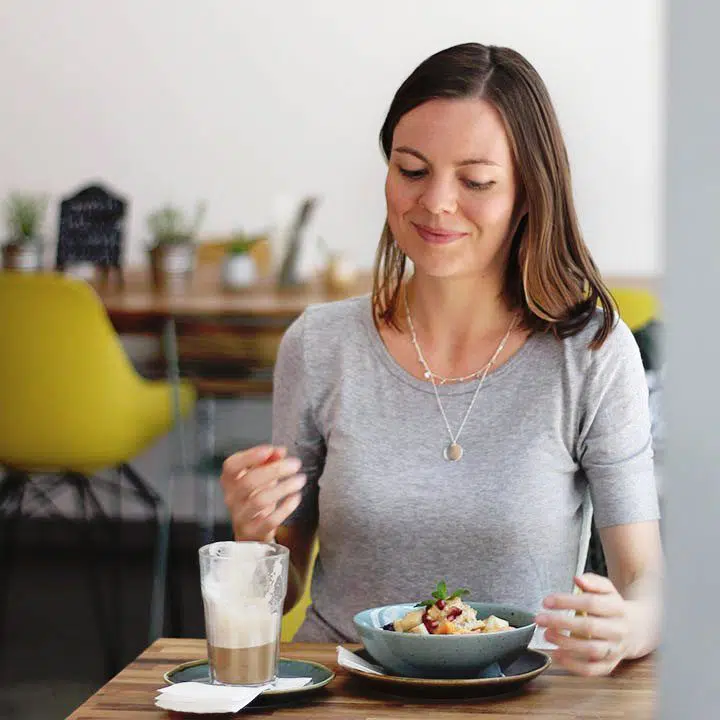
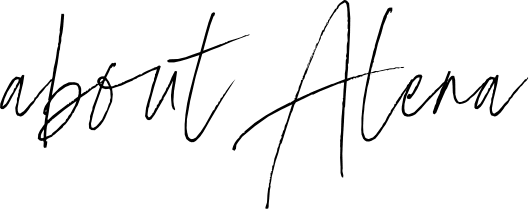 Alena Schowalter is a Certified Vegan Nutritionist who has been a vegetarian since childhood and vegan since 2012. Together with her husband, she founded nutriciously in 2015 and has been guiding thousands of people through different transition stages towards a healthy plant-based diet. She’s received training in the fields of nutrition, music therapy and social work. Alena enjoys discussions around vegan ethics, walks through nature and creating new recipes.
Alena Schowalter is a Certified Vegan Nutritionist who has been a vegetarian since childhood and vegan since 2012. Together with her husband, she founded nutriciously in 2015 and has been guiding thousands of people through different transition stages towards a healthy plant-based diet. She’s received training in the fields of nutrition, music therapy and social work. Alena enjoys discussions around vegan ethics, walks through nature and creating new recipes.
Hey! This info is very interesting and useful! Thank you very much :) If you want another idea for a new article (hehehe), I suggest you an example menu for women, in which all those nutrients are included in the recommended daily amount.
Thank you!!!
Always open to new ideas, hehe. Thanks for the commend, we’d love to create such helpful content – a sample menu for women would make total sense. Added to our list… but be warned, it’s already a rather long one ;)
Best wishes!
Thank you for making this easier for me. X
Glad to have helped!
Nice breakdown of a proper vegan diet! Thanks for sharing!
Thanks for checking it out :)
This is so well researched, I’ll definitely be sending this source to others!
jenny x | http://www.jennyrosee.com
How lovely, Jenny… thanks so much for popping and! We’re happy you found this valuable and would be honored if you decided to share, of course :) Your blog looks lovely, cannot wait to check it out!
That pyramid is so helpful!
Thanks, happy to know it was helpful to you!
Wow this is so informative. Thank you so much
Another vegan blogger from Germany :) Thanks for checking in, much love to our home country… where are you from? We last lived near Frankfurt but were born a little more southern.
Hello!
Thank you for the article.
Please help me understand the combination of products
there are grains, vegetables, fruits, legumes, nuts and seeds.
What is it worth to combine and what not.
And how about a freshly prepared smoothie – this is not the whole meal.
Thank you!
How can I access the pyramid? It is not letting me download it :(
Hey Nicole,
sorry to hear that you’re having issues – are you sure you entered the correct email address? Usually, this always works (just tried it again myself) but if you keep having trouble, just message us your email address and we’ll send it over directly :)
Thanks and have a lovely Sunday!
– Alena
Dear Alena… Thank you so much for your email. The information you shared has been very helpful. I still have to put this all together, but the various sections will serve to accomplish my goals. The information regarding the nutrients is especially helpful, as a friend has been concerned about my getting enough protein to keep my old bones and muscles, etc. happy and healthy. With this in mind, would it be possible for me to still obtain your Summer Sale books… “Vegan Starter Kit” and “Weight Loss System” in August, at the reduced prices. I am a 70 year old senior and will receive my Social Security on August 3rd. Hope your summer has been dry, cool and wonderful. We folks in the St. Louis, Missouri region have been inundated with rain and excessive heat index periods around 105-110+ degrees. The Mississippi River has created copious flooding of towns located on the river and outlying rural and farming areas. Again, your information is very much appreciated.
Sincerely, Barb N.
Dear Barbara,
thanks for your comment and lovely feedback! I’ll get in touch with you via email and set you up with a special discount for our eBooks – we’re so inspired by you that you’re up for this lifestyle change at your age and would love to support your efforts.
I heard that St. Louis has a growing vegan community! Alex MacDowell from Mr & Mrs Vegan often shares great restaurant and food options online if you want to connect with him. This year, climate change is really showing again with all these heatwaves here in Germany. Right now, the weather is lovely, though.
I’ll get in touch via email and thanks again!
Best wishes,
Alena
Thank you so much, this is so helpful. Love everything I’ve read about. My family has been vegan for a little over a year and a half but this helps so much. Love getting the emails and reading new stuff too. Thanks again
Thanks so much for this info! .. I’ve been trying to figure out why I can’t lose weight on just a fruit and veggie diet. That’s because I havent been eating all the foods I should be eating. I have downloaded this and hope it helps in the long run!
Hello!! this is really interesting. I am new and I am trying to learn everything I can of plant based diets. An actual concern its how can I know the servings that my body needs for my age, excersice and body goals… considering that I am getting all the nutrients my body needs each day.
Do you have another cheat sheet but of this kind of objective?
thanks
Hey Ana,
great question! We generally advise to eat until you’re satisfied and adjusting the calorie density to your health and weight goals. The USDA has sedentary to moderately active adult females at around 2000 calories (https://health.gov/dietaryguidelines/2015/guidelines/appendix-2/) which is what our 2-Week Meal Plan in the Vegan Starter Kit contains. Maybe the chart I just linked is helpful to you – love the idea of creating a cheat sheet for this in terms of plant-based eating :)
If you want to lose weight and aren’t very active, focus more on brown rice, potatoes and veggies – and if you’re active or having a hard time to get enough calories, eat your veggies in smoothies or pasta bakes, add more nut butter and so on. Hope this helps!
Best wishes,
Alena
I am 14 years old, should I eat half of the serving suggestions?
Hi Kate,
thanks for getting in touch! The USDA states that females at the age of 14 should eat at least 1800 calories per day (https://health.gov/dietaryguidelines/2015/guidelines/appendix-2/) and when eating all the suggested servings, you will most likely stay below this number – some room for fun food!
We’d love for you to listen to your hunger cues and eat from all the food groups, when you’re not feeling energized enough then add more whole grains or nuts and seeds to increase the amount of calories. If you have a huuuuge appetite and gain weight easily, have more veggies instead. Hope this makes sense :)
Best wishes,
Alena
Thank you very much for this very helpful article. I am vegan for to months very confused but no more after reading your article
so happy to read that! thanks for the feedback :)
Hi Alena!
Thank you so much for this! However, I can’t seem to download the pyramid/cheat sheet. :( Would it be okay to email it instead? Thank you! :)
Hi Sophia,
thanks for getting in touch! I just sent it to you, please quickly reply to me once you receive it :)
Glad that you like our work and let me know if you need any other support!
Best wishes,
Alena
Brown and all rice has a lot of arsenic in it which is a carcinogen. We need to strongly limit our consumption of it. 2 servings per week at the most. Not what your food pyramid is showing!
BTW – The very best bona fide research on plant based nutrition is on nutritionfacts.org – a not for profit website. Dr Greger supplies free daily emails with the latest in nutrition research written in such a way that a lay person can easily understand them. Dr Greger has also written books called How Not To Die, with an accompanying How Not To Die Cookbook and How Not To Diet also with an accompanying How Not To Diet Cookbook. All proceeds going to the not for profit organization.
Thank you for this! I have been eating a vegetarian diet nearly 3 years. I definitely had to re-learn how to cook/eat when I started to eat this way. When I began (well, once I got the hang of it) I was pretty good at eating a balanced diet, making vegetables and grains the stars of my meals, and eating little to no plant-based meat substitutes. Since then I have become more lax and reached more for convenience (now a mother of 2). I am looking to get back there and this time cut dairy as well so this information has been super helpful!
Hi Patricia, happy to know that you enjoy our content! Just a little note, plant-based meat substitutes can differ vastly from one another :) Some mock chicken brands have a very straightforward and healthy ingredients list, while others contain much more saturated fat or are breaded, etc. Do you like soy curls or TVP? They offer a mix of healthy protein and convenience: https://nutriciously.com/what-is-tvp/
I wanna be a vegan and this article is so useful for me. Thank you nutriciouslyfor sharing. I’m waiting for new articles.
Would love to go vegan, but I’m gluten free and I don’t eat legumes at all, I just really hate it, since I was a child. I’ve tried but really don’t like any of it. Would love to find better ideas for veggies cooking.
Hi Bernadette, thanks for sharing! I understand that it’s a lot tougher to follow a vegan diet that also excludes gluten and legumes. Have you tried foods like lentil pasta or hummus? I love including beans in sauces or smoothies because I personally find them hard to digest. Here are some recipe ideas: https://nutriciously.com/strawberry-bean-smoothie/ + https://nutriciously.com/oil-free-pesto/ . You can find gluten free recipes here: https://nutriciously.com/gluten-free-vegan-recipes/ and I suggest you try cooking or baking with silken tofu (a legume but can be transformed in many tasty dishes!) https://nutriciously.com/silken-tofu-recipes/ or TVP https://nutriciously.com/tvp-recipes/
best wishes!